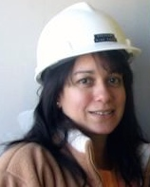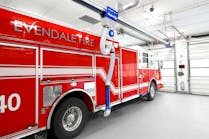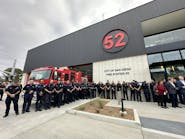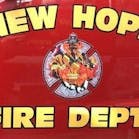15 Questions to Ask Your Architect/Engineer Candidates
Fire chiefs and their staffs are experienced veterans when it comes to leading fire departments, managing community crisis, hiring personnel, purchasing equipment and specifying apparatus. However, most of these chiefs are operating out of small departments with facilities that have been around for 25, 50 or even more than 75 years. As such, the likelihood of them having much experience with a building project—and specifically hiring an architect/engineer (A/E) for a station renovation, expansion, replacement or addition—is rare.
Dealing with facility issues often requires finding expertise outside the fire department. You will need funding, procurement services, project and construction management specialists, an A/E team and a general contractor. It is important that you assemble the team yourself. Don’t hire the architect and have them assemble the team, as someone like the mechanical, electrical and plumbing (MEP) engineer can be equally important to the success or failure of any fire station project. Create a partnership among these various entities from the beginning.
The following is a list of questions to ask when selecting your A/E team. These questions can be answered while talking to potential A/Es at industry trade shows, fire station design conferences or during the selection process. Every building project has a story in which the A/E team has a critical role. It’s important to get an A/E team with the most positive stories and most collaborative spirit. Proactive research on your part will be critical and is priceless!
1. What is your firm’s experience building fire stations?
Fire stations are very complex facilities, and other than aircraft carriers and prisons, are one of few unique facilities that are both office and a home 24/7 and 365 days each year. Do not focus on the quantity of stations in their portfolio, but rather the quality of what they built.
2. Who are your MEP, civil and structural consultants?
MEP consultants are critical to fire stations during design and construction. We have traveled across the country and visited more than 50 new stations in the past 12 years. The MEP components are usually the most problematic and least obvious until the building is complete. It is important to check references on all consultants.
3. Does the A/E team have experience in specialized fire station components driven by such needs as ISO, accreditation, training, disaster preparedness, communications and unique department/community needs?
Having someone on the team who speaks your language and comes from the fire service is critical. If they don’t have that member, request that they add a fire station design consultant to the team.
4. Has the A/E team worked together?
Teams that have worked together have an edge over teams that have not. Getting two well-known consultants who have never worked together often presents challenges with coordination and, ultimately, quality control. If they have worked together, those issues are not being worked out at your expense. Get a list of stations they have worked on and contact the users for feedback.
5. Has there ever been any litigation from any of your past projects?
This should be looked into for both the architect and MEP, separately. It doesn’t have to be directed at them, just the project. Litigation is often the result of errors or omissions on drawings, missed items during bid, or breach of contract by the general contractor. It is important to find out the whole story.
6. Who is your internal project team during design and then during construction? Will there be continuity?
You want the “A” team from any A/E firm. It is important to check references. Equally important is to find out about continuity of personnel from design through construction. During construction, firms sometimes bring in lesser-experienced members who may be well qualified technically but do not have institutional memory of why certain things were included during design. Thus, substitution requests or deletion of items that are important to the department may occur without the department knowing about it until they occupy the building.
7. Will you be using Building Information Management (BIM) during design?
This is a 3-D tool that significantly reduces coordination in the field. Most non-residential A/E firms have this and should use it in the project regardless of whether it is new construction or a renovation.
8. What is a project you are proudest of and why?
Have they received any design awards or user feedback? Obviously the latter is very important to you. The building must function well.
9. What is a project you are least proud of and why?
Was it litigation? An unrealistic schedule? A difficult contractor or subcontractor? A difficult client? It is important to know the whole story to avoid similar mistakes.
10. How willing are you to listen to the client (as opposed to imposing your own design style)?
Contact references and ask about the proposed team, during design and construction. Beware of stubborn A/E teams. Conversely, give them the respect they deserve, as you are hiring them as experts.
11. How do you propose to approach the project, from programming through construction?
Do they do a Needs Assessment? How many other consultants will they bring in at various phases? Ask about their quality control during design and construction. Again, you can have a great design but if it is not carefully shepherded and protected during construction, the results can be disappointing to disastrous.
12. Do you have resources with experience to help to select fixtures, furniture and equipment?
This is a very important component that’s often shoved onto department members who are ill-equipped to specify, and provide the cut sheets on everything specified, to the team early enough to be incorporated into design. Identify this resource, either internally or externally, early on.
13. Can you provide us with your overall fees for your five previous projects?
Ask for Total Construction costs at the end of the project, including change orders. Similarly, ask about their fees, including add services, at the end of the project. The range should be 8-11 percent of total construction. Tight sites or renovations tend to be higher.
14. What was the price spread on bids for your last three projects?
Assuming projects were bid after construction documents were 95 to 100 percent complete, if the spread between bids was within 5 percent, drawings are excellent. If it was 20 percent or more, that is cause for concern.
15. Have you conducted post-occupancy evaluations of projects with occupants one to two years after occupancy and, if so, do you have any lessons learned from those projects?
This is a key step if firms care about learning from previous projects. If they haven’t conducted any, it is a red flag. Also, lessons learned are important to learn about as they reveal the character of the team and may help you avoid some pitfalls.
In sum
A building project is a marriage, and you want to know as much about your partners before entering into that partnership. What is not revealed is often just as important as what is. And similar to a marriage, it is important to enter into the project as a team, with you, the A/E team and the general contractor all being equal and respectful partners; otherwise, it is bound for failure.
The Good Client
Before commencing on any project, be mindful that you need to be a good and reasonable client. Insisting on a very tight schedule, and changing design or adding scope during construction, adds burden to the entire team. There are three main components to any project: time, money and quality. Being reasonable about time and money should guarantee a high-quality product. If you squeeze either time or money, quality often suffers.

David Hartman
Battalion Chief David Hartman (Ret.) served with the Charlottesville, VA, Fire Department for 33 years in several leadership roles, culminating as the department’s special operations battalion chief. After retirement in 2010, he served as the owner representative for 4½ years during the planning, design and construction of the Fontaine Fire Station and Training Center. David earned his bachelor of business degree from James Madison University.

Mashal Afredi Hartman
Senior Project Manager Mashal Afredi Hartman has worked as a project manager for University of Virginia Facilities Management for more than 17 years and has successfully managed more than $226 million worth of projects during that time.
David and Mashal are co-owners of Hartman Fire Station Consultants, LCC and can be reached at [email protected].






